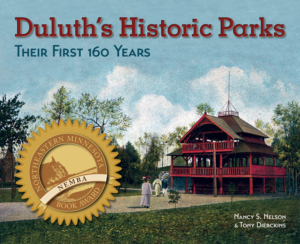Skyline Parkway & Seven Bridges Road

Two Duluthians on horseback, ca. 1893, enjoy a rest while touring Terrace Parkway, the original section of today’s Skyline Parkway, named Rogers Boulevard in 1894. [Image: University of Minnesota Duluth Kathryn A. Martin Library Archives and Special Collections]
The Western Extension
Although the park board apparently did not have plans for extending the parkway beyond the original section, newspaper editorials soon began to predict that the road would someday reach all the way to the Dalles of the St. Louis River and along the North Shore of Lake Superior beyond the Lester River.
William K. Rogers had actually roughed out an extension of the road from Miller Creek to Fortieth Avenue West by 1890, using money he borrowed from Leonidas Merritt, a prominent West Duluth businessman. Most of this roadway remained in a “state of nature” according to board secretary Henry Helm, and in September 1903 members of the West Duluth Commercial Club began lobbying the park board to finish the western extension. In 1904 the board agreed to start work on extending the road from Lincoln Park to Fortieth Avenue West.
At the end of that year, secretary Helm reported that “a large amount of work was required…to put the roadway in passable condition from Twenty-eighth Avenue to the westerly terminus,” the section that had been partially constructed fourteen years earlier. Three extensive ravines had been encountered, delaying work and adding to the cost. In addition, “in some instances the work of former years was found to be a hindrance rather than a benefit; since it had become necessary to tear down before building up in a more permanent and lasting manner.”
In 1905 the board acquired the right-of-way to extend the parkway from Fortieth Avenue West to approximately Sixty-fourth Avenue West. During 1906 and 1907, laborers worked on filling the deep ravine at Fortieth Avenue West, which the board reported was the slowest and most expensive part of the whole job. When hiring a contractor, the News Tribune reported that the park board hoped to find a large firm that would keep the men and teams on the project until it was completed, because “it is pointed out that the distance from the car lines is so great that the men employed on the job would consume much time daily in going and coming. If they camp on the spot much time will be saved.”
Secretary Helm announced in October 1908 that the parkway extension to the Oneota Cemetery was complete, and the News Tribune reported that on October 17 “about sixty men and women, mostly from West Duluth, made a trip over the new boulevard extension yesterday afternoon in automobiles, tallyhos, and carriages… The work was done at a cost of $4,000, including the purchase of the right of way.”
By this time many people owned automobiles, and the new road became such a popular place for driving that in July 1909 the board members decided it was necessary to regulate travel on the western extension. They adopted the following regulations: “1. All vehicles must be driven east to west, only. 2. Automobiles must not be driven at a speed greater than twelve miles per hour, and must slow down to six miles per hour or less at short turns or narrow spaces in the roadway where signs will be displayed for the guidance of all drivers.”
In the spring of 1912, the park board began work on adding three more miles from Sixty-fourth Avenue West to the upper end of Fairmount Park near Thompson Hill. The News Tribune wrote enthusiastically, “This will give Duluth a boulevard driveway 18 miles long, the most picturesque highway in the world, whose scenic beauties are unequaled anywhere, and an attraction that should of itself bring thousands of visitors each summer.”
Work on this final segment proceeded relatively fast, and by 1913 the work was completed. The park board’s 1912 annual report indicated that $6,253.03 had been spent on construction of the western extension of the boulevard from Oneota Cemetery to Earl Street (now called Proctor Road).
The Eastern End of the Parkway
The park board made no effort to extend Rogers Boulevard east of Chester Creek. To access the eastern end of the parkway from London Road, a horse and buggy had to make the steep uphill climb on Fifteenth Avenue East and Chester Park Drive. (At this time there was no bridge across Chester Creek between Fourth Street and the parkway; the Eighth Street bridge over the creek was not built until 1920.)
In September 1906, a number of prominent residents of the East End, including future park commissioner F. A. Patrick, approached the board with a request to establish a new connection to the eastern end of the parkway that would provide access with an easier (less steep) grade. Patrick described the existing approach as “very hard on horses, as you know if you have ever ridden up it, and I know that I hesitate to drive my horses over it owing to the exceedingly hard character of the pull.” The proposed connection followed Eighth Street west from Woodland Avenue, then up the “partially improved” Nineteenth Avenue approximately four blocks, “to a point where it was required to construct another stretch of new roadway for the remaining distance of some four hundred feet.” The citizens offered to pay for the improvement, and the park board agreed to oversee the work. The new connection, known as the “cut-off,” was completed in the summer of 1907. The new four hundred foot long stretch later became part of West Kent Road.










